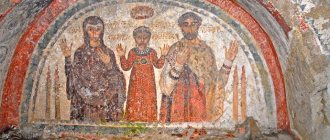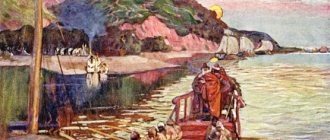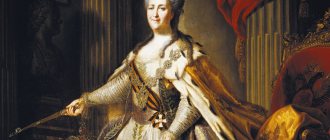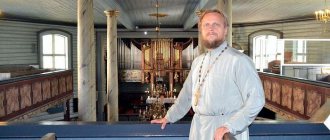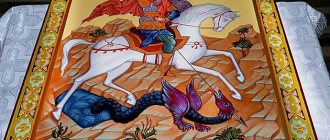In Libya, where the crusaders went, there was a small lake with fresh water. It was this that saved many people from thirst. One day, a large, scary dragon appeared on the shore of this lake. He did not allow anyone near the water until a child was sacrificed to him.
Saint George passed not far from this place. He suggested that people get rid of the monster if they convert to Christianity. People agreed. Then Saint George defeated the dragon, and this city became one of the cities where Christianity began to develop. A church was built on the spot where the terrible dragon was struck.
The patron saint of England is Saint George. This is one of the most famous and revered saints in the entire Orthodox world. He is also known as St. George the Victorious.
The patron saint of England is St. George the Victorious. Photo: pp.userapi.com
It is generally accepted that St. George the Victorious is the patron saint of England.
According to the generally accepted version, England had another patron. The very first patron was Saint Edmund. His memory was celebrated on November 20. Currently, it has been relegated to the background.
The process of this forgetting began to occur from the time of the settlement of the Normans on these lands. The Normans tried very hard to replace the veneration of St. Edmund with the veneration of St. George the Victorious.
Saint Edmund is considered to be the first patron saint of England. Photo: 2.bp.blogspot.com
Little information has been preserved about the life of this heavenly patron. It is believed that he was born on the territory of modern Turkey. His family was quite rich. The family revered the Christian faith. George served in the Roman army. In 303 it happened that he was beheaded by order of the emperor because he refused to renounce his Christianity.
Martyr Albanius
As in Rome itself, Britain's early Christians were persecuted. At the beginning of the 4th century, the first British martyr Albanius is already known.
He hid a Christian priest who was being persecuted by the Roman occupation authorities. The Romans discovered the whereabouts of the priest, but Albanius did not give him up. Dressed in his clothes, he gave the priest the opportunity to escape, and he himself surrendered to the Roman soldiers. Mistaking him for a Christian priest, the Romans sentenced Albanius to death.
The city in which Albania was executed has been named after him for many centuries and is called St. Albans. For centuries, hundreds of pilgrims have been drawn to the tomb of the first martyr of Albania. Since 1928, the Commonwealth of St. Albanius and St. Sergius of Radonezh has been operating in England. The purpose of the Commonwealth is to bring the Anglican Church closer to Orthodoxy. Such famous theologians and historians as Bishop Kassian Bezobrazov, Archpriests Sergius Bulgakov, Georgy Florovsky, Alexander Shmeman, Vasily Zenkovsky, A.V. Kartashev, N.A. Berdyaev spoke at the Commonwealth congresses. The spiritual leader of the Commonwealth of Saints Albania and Sergius at one time was Metropolitan Anthony of Sourozh.
In Britain, Saint George became known in the 8th century.
In Britain it became known in the 8th century. By the 11th century, the first church was built in his honor. After some time, a very interesting story appeared about him.
In one of the crusades, Saint George appeared before an army of Christians on horseback in shining armor. This is what decided the outcome of the battle. This is how George became the heavenly patron of the British land.
During the time of Richard the Lionheart, George received the official title of George as a heavenly patron.
St. George's Day in England is celebrated on April 23
St. George's Day in England is celebrated on April 23. Back in the Middle Ages, this day was celebrated on a par with Christmas.
The St. George's Cross is also considered one of the symbols of the defender of Britain. The well-known red cross on a white cloth appeared on the British uniform, which became the prototype of the flag of their country. In the 14th century, this cross also became the official emblem of Great Britain. It becomes official along with other symbols of Scotland and Ireland, as well as the crosses of St. Patrick and St. Andrew.
This is what the flag of England currently looks like
Also, all Englishmen know the legend of how St. George kills the terrible dragon. The legend appeared back in the 10th century. In Libya, where the crusaders once went, there was a small lake with fresh water. It was this that saved many people from thirst and death. One day, a large, scary dragon appeared on the shore of this lake. He did not allow anyone near the water until a child was sacrificed to him. The locals did just that. But this continued until the lot fell on one of the daughters of the local ruler.
It turned out that Saint George was passing not far from this place. He suggested that people get rid of the monster if they convert to Christianity. He offered himself to fight the dragon.
People agreed. Then Saint George defeated the dragon, and this city became one of the cities where Christianity began to develop. A church was built on the spot where the terrible dragon was struck. It is also believed that the dragon is an allegorical image of paganism, which was so widespread at that time. Paganism then began to embrace human sacrifice.
Reverend Melangella
In Wales, in the kingdom of Powys, one recluse with the name Melangella labored. She was the daughter of an Irish king, but she left her father and the kingdom and sailed across the Irish Sea to go into the wilds of central Wales and settle there in a small cell.
One day, the king of these places, Brochfel Isgifrog, while hunting a hare, saw a young girl kneeling and praying, and a frightened hare stood on the folds of her dress. The hunting dogs froze in place - some force prevented them from approaching the hermit. Brochfel yelled at the dogs in anger, but they ran away screaming. Surprised by such strange behavior of the dogs, the king asked the stranger who she was and what her name was. The girl replied: “I am the daughter of the King of Ireland. My father forced me into an unwanted marriage and I ran away from him. For 15 years now I have been living in these forests in complete seclusion and have not seen a single person’s face.”
When King Brochfel saw the beauty of Melangella, he began to ask the girl to become his wife and queen of Powys, but the girl meekly and confidently rejected Brochfel's offer. Struck by her Christian life, Brochfel immediately granted Melangella the entire forest and the surrounding lands and said that from now on anyone who, hiding from pursuit, reaches this holy place can live here fearlessly with Melangella’s blessing.
In the donated territories, Saint Melangella founded a convent, of which she remained abbess for 37 years, until her death in 590. Even during her lifetime, Melangella became famous for many miracles, and in Wales she is still called the patroness of wild hares, which locals call “Melangella’s lambs.”
Currently, people pray to the icon of St. George, asking for his help and protection
They still pray to Saint George to this day. Divine liturgies are held in churches. At home, people read prayers, praising the great Martyr George. Also, prayers are read at his icon for lost children, during attacks by wild animals, and for the preservation of the lives of soldiers. People also read these prayers, asking for help in difficult moments of their lives.
The first prayer to the holy Great Martyr George the Victorious , read about lost children during the attack of wild animals and protecting the lives of soldiers on the battlefield:
Holy, glorious and all-praised Great Martyr of Christ George! Gathered in your temple and in front of your holy icon, people worshiping, we pray to you, known to the desires of our intercessor: pray with us and for us, beseeching God from His mercy, that He may mercifully hear us asking for His goodness, and not abandon all ours to salvation and life needful petition, and may the grace given to you strengthen the Orthodox army in battle, may the enemy destroy the forces of the rebels, may they be ashamed and put to shame, and may their insolence be crushed, and may they know that we are imams of Divine help; and show your powerful intercession to all who are in sorrow and distress. Pray to the Lord God, the Creator of all creation, to deliver us from eternal torment, so that we may always glorify the Father and the Son and the Holy Spirit, and we confess your intercession, now and ever and unto ages of ages. Amen.
Second prayer to the Holy Great Martyr George the Victorious for help in difficult times and protection from enemies:
O all-praised holy great martyr and wonderworker George! Look upon us with your quick help and beg God, the lover of mankind, not to judge us sinners according to our iniquities, but to deal with us according to His great mercy. Do not despise our prayer, but ask us
Christ our God, a quiet and godly life, mental and physical health, fertility of the earth and abundance in everything, and may we not turn into evil the good things given to us by you from the all-generous God, but for the glory of His holy name and for the glorification of your strong intercession, yes May He grant our Orthodox people victory over their adversaries and strengthen us with unchangeable peace and blessing. May the saints protect us more generously
The Angel of His militia will deliver us, after our departure from this life, from the wiles of the evil one and his difficult airy ordeals, and to present ourselves uncondemned to the throne of the Lord of glory. Hear us, passion-bearing George of Christ, and pray for us unceasingly to the Trinitarian Lord of all God, so that by His grace and love for mankind, with your help and intercession, we may find mercy with the Angels and Archangels and all the saints at the right hand of the just Judge, and we may glorify him with the Father and Holy Spirit, now and ever and unto ages of ages. Amen.
The patron saint of Scotland is Saint Andrew
There are also other patron saints of these lands. The patron saint of Scotland is Saint Andrew. This saint was one of the twelve apostles of Jesus Christ. By his profession, he was a simple fisherman. Saint Andrew is also considered the patron saint of Russia and Greece. Andrew also preached Christianity, like Saint George.
Patron Saint of Scotland - Saint Andrew the First-Called
Andrew suffered martyrdom in 62 AD in the city of Patras. He was crucified on a diagonal cross, which later became a symbol on the flag of Scotland. When the ruler saw Andrei preaching about God, he ordered his arrest and crucification. For several days Saint Andrew hung on the cross, teaching all the townspeople the Christian faith.
Saint Andrew accepted martyrdom for his faith. Photo: cyrillitsa.ru
There are also many theories according to which St. Andrew was chosen as the patron saint of Scotland. According to one version, in the middle of the 4th century, Emperor Constantine the Great ordered the transfer of the relics of St. Andrew from Patrasa to Constantinople. He entrusted this task to one monk. At night, an angel appeared to the monk in a dream, who said that most of the remains should be taken to the northeast. When the monk was crossing by ship, they were overtaken by a storm. The ship was wrecked, and the monk, along with his relics, washed up on the eastern coast of Scotland itself.
There is also another legend with the name of St. Andrew as a heavenly patron. In the 8th century, an army led by King Hungus was surrounded by an army of English. The king prayed to God all night that they would be granted victory and that his army would defend. At night, Saint Andrew appeared to the king, who promised them victory.
The next morning, when the battle began, everyone saw a white cross above them against the blue sky. Saint Andrew was crucified on exactly the same cross. This vision greatly frightened the opponents that they were defeated. After this victory, Saint Andrew was proclaimed the patron saint of Scotland.
Reverend Kevin
Almost every British or Irish city has its own patron saint. If in London this is the Apostle Paul, then in ancient Dublin the heavenly patron is the Reverend Kevin of Glendalock (498-618). This is one of the most “popular” saints in Ireland, whose name the Irish name their children no less often than the name Patrick.
Saint Kevin belonged to the royal family of rulers of Leinster (east coast of Ireland). From early youth, he was brought up at the monastery of his uncle, the abbot, where he studied the Scriptures, modestly performed various obediences, and prepared to live his whole life devoting himself to Christ. But soon, due to the persistent pursuit of one girl, whose attention was attracted by the beauty of the young monk (even the name “Kevin” itself is translated from Irish as “born beautiful”), he is forced to secretly leave the monastery and retire to a deserted place. The fugitive lives in a hollow tree, eating only grass and fruits, but the saint's refuge still becomes known, and he has to return home. And when, according to life, Kevin returns to the monastery, even the trees in one difficult forest bend towards his feet, thereby making the path easier. The saint blesses this forest, which later receives the name Hollywood (Hollywood) or “Holy Forest” (the famous city of Hollywood in the US state of Florida received its name from Irish emigrants who, even in exile, sacredly honored the memory of St. Kevin).
Soon Kevin is ordained to the priesthood and blessed to found his own monastery. The young priest immediately returns to the place of his former solitude, and numerous brethren settle next to him. This is how the Glendallock monastery was formed, which became one of the main monasteries in Ireland with its famous monastic school, and later grew to such a size that it became an independent diocese?
Prayers for the healing of the sick are read in front of the icon of St. Andrew the First-Called
This saint is also known as Andrew the First-Called, as he was one of the first disciples of Jesus Christ. People often pray to him and ask for help.
In front of the icon of St. Andrew the First-Called, prayers are read for the healing of the sick and possessed.
Prayer to Apostle Andrew the First-Called:
First-Called Apostle of God and our Savior Jesus Christ, Church follower, all-praised Andrew! We glorify and magnify your apostolic works, we sweetly remember your blessed coming to us, we bless your honorable suffering, which you endured for Christ, we kiss your sacred relics, we honor your holy memory and believe that the Lord lives, and your soul lives and with
You are forever in heaven, where you love us with the same love with which you loved us, when by the Holy Spirit you saw our conversion to Christ, and not only loved, but also prayed to God for us, in vain in His light all our needs . This is how we believe and this is how we confess our faith in the temple, which was gloriously created in your name, Saint Andrew, where your holy relics rest:
Believers, we ask and pray to the Lord and God and our Savior Jesus Christ, that through your prayers, whoever ever listens and accepts, will give us everything we need for the salvation of us sinners: as if you were abiding by the voice of the Lord, leave your hesitation, and follow Him unswervingly. , this and every one of us, let him not seek his own, but let him think about the creation of his neighbor and about the heavenly calling.
Having you as an intercessor and prayer book for us, we hope that your prayer can accomplish much before our Lord and Savior Jesus Christ, to Him belongs all glory, honor and worship with the Father and the Holy Spirit and forever and ever. Amen.
By leaving a comment, you accept the user agreement


